Document Type : Scientific research
Authors
1 tehran university
2 tehran
Abstract
Introduction
The main purpose of the law regarding the consumers’ rights is to create equality in the relation between producers and suppliers on the one hand and the suppliers and the consumers on the other hand. The applied commutative justice takes the relationships and the differences in the contractual power into account without abusing the weaker party rights by considering the state intervention in the relation between producers and consumers justifiable due to the importance of economic liberalization, the expansion of mass production, the increasing number of multinational companies, and the unequal power of the parties in consumption. Thus, the established commutative balance or justice requires both parties’ agreement. Accordingly, the law on consumption is formed with the idea of establishing balance and regulating the relations by imposing certain conditions on the stronger side (producers and suppliers) and identifying legal rights for the weaker party (consumers).
Theoretical Framework
In the Iranian statutory law, the consumer rights faces many challenges such as the lack of clarity of consumer concepts, the lack of access to information, lengthy legal proceedings, heavy costs of litigation, and the producers’ dependence on state-owned as well as quasi-governmental institutions. Thus, what will be focused in this essay is merely the role of a class action in solving the challenges posed by the cost of the proceedings, the length of the proceedings, and the lawyers wages,.many of these challenges have been solved by class action while at the same time class action increasing the efficiency of consumer reparations methods. In so doing, firstly, the class actions are described and secondly, the legal challenges of the proceedings in the realm of consumers’ rights will be explained. Ultimately, the role of the class actions in solving these challenges will be addressed. At the same time , some Opposition regarding the necessity of the class actions are mainly based on the foreign countries proceeding and legal systems. therefore , We do not explain these views and only considering the barriers of brining a class action in Iranian law and how to apply this method of procedure suffices.
Methodology
This study attempts to find an answer to questions above by using an analytical-descriptive approach. To this aim, the present study seeks to examine the existing challenges of protecting the consumer rights in Iran while reviewing the class action lawsuit to ensure their rights.
Results and Discussion
Consumers’ rights have two main purposes: correcting the product defects and protecting the consumers’ loss. The present study showed that the identification of class actions is the complementary factor and the final circle of providing the desired goals since the goals of class actions system are increasing judicial efficiency, reducing the costs of court proceedings, saving the costs of bringing the dispute, increasing the parties access to the legal solutions, preventing the conflicting decisions over time, and predicating the judicial processes which promotes the consumers’ rights on the one hand and improves the production processes on the other hand. However, this research additionally showed that the use of class actions in the realm of consumer rights requires reducing the workload of the courts, the cost of proceedings as well as preventing the conflicting views which can lead to gaining one of the most important goals of consumers’ rights namely deterrence. The consumer rights can be accomplished if the producers are more careful in terms of complying with the product standards and informing the consumers about a defect or deficiency in the products. This may be done slowly or may not be accomplished in the absence of a solution such as a class action. This issue highlights the importance of using this solution namely ‘resorting to the class actions’ in completing the substantive efforts to support the consumers.
Keywords


Send comment about this article